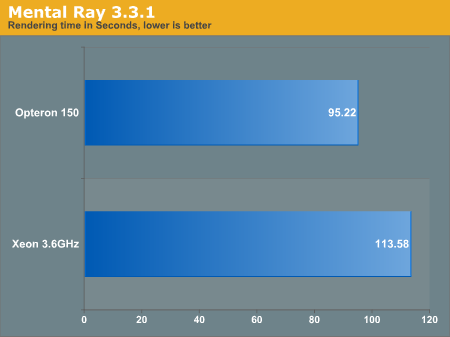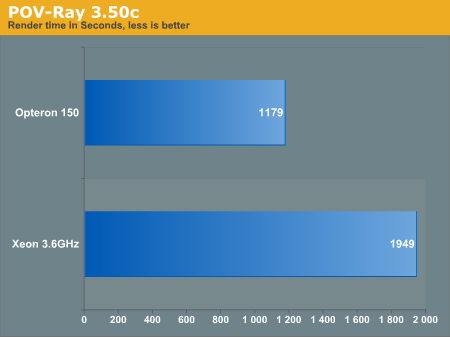Linux Shootout: Opteron 150 vs. Xeon 3.6 Nocona
by Kristopher Kubicki on August 12, 2004 2:35 PM EST- Posted in
- Linux
Mental Ray
Between Mental Ray and POV-Ray, we should see our largest taxing of the floating point in a real world scenario.
We ran Mental Ray 3.3.3 from the command line on the same benchmark file we have been using in the past. Unfortunately we do not have access to 64-bit Maya/Mental Ray binaries at this time, but we are working with AW.

The Opteron outperforms the Nocona in this benchmark but we would like to see x86_64 tests in the future.
POV-Ray
POV-Ray was installed from RPM, and then run against the official benchmark.ini.

As we can see above, the difference between the two CPUs seems exaggerated and difficult to trust. We are working with the POV-Ray team to determine why the differences are so dramatic.










92 Comments
View All Comments
menads - Thursday, August 12, 2004 - link
Now all I want to say is big thanks for listening to your readers. Unlike other site which I would not mention that claims they are never wrong I think it is very nice of Anandtech editors to accept the criticizm and feedback from their readers and to get back retesting/reviewing.It is not about scores or brands - it is about the trust of the people reading these arcticles - a misleading review in most cases is worse than non-review.
Also Kristoper please do not take criticizm of the previous article personally - by criticizing your article most people were hoping you will do better next time.
KristopherKubicki - Thursday, August 12, 2004 - link
Hi Tau,>Handcoding ASM for specific tasks is NOT ancient
No youre correct. The context of the sentence though its the hand coded ASM used in 3.6 "stable" is ancient. Someone pointed out to me it doesnt even have the original MMX optimizations in it (i think).
Kristopher
Jeff7181 - Thursday, August 12, 2004 - link
What's that sound? I hear heavy footsteps and heavy breathing... oh... wait... it's the Xeon trying to keep pace with the Opteron :DSDA - Thursday, August 12, 2004 - link
Yeah, gj Kris, and yeah, I'd say you deserve a vacation after all that... thanks for listening to people, that's a lot more than certain editors at certain sites COUGHCOUGHTHGCOUGH would do.Pirox - Thursday, August 12, 2004 - link
Lmao...i got hand to kriz though ..you sure are one tough guy! Nice article...and to think that the guy remains calm...what gives?KristopherKubicki - Thursday, August 12, 2004 - link
Lynx516:Parts of 3.4.1 are backported into 3.3.3. Please check the SuSE 9.1 man pages.
Kristopher
TauCeti - Thursday, August 12, 2004 - link
Hi Kris,First: I appreciate the work you put into this review. But i cannot restrain to offer one (hopefully constructive) remark:
you write: "We are using John the Ripper 1.6.37 in this portion of the benchmark. As a few extremely knowledgeable readers pointed out, the "stable" 1.6 branch of code relies heavily on hand coded ASM which by today's standards is fairly ancient anyway."
Handcoding ASM for specific tasks is NOT ancient. Handcoded ASM allows you to utilize the execution units and the cache-latency distribution of a given core architecture to fullest extend.
That is of uttermost importance to widespread library functions used in scientific calculations. Even the popular GIMPS client is handcoded in ASM for every CPU-variation (there are even different codepaths for different cache sizes). The GIMPS developers are fighting for every single clock that can be saved in a inner loop for different architectures.
That aside...
Have a nice vacation. I guess you ned it ;)
If you - for yourself - agree that you could have done better, swallow your pride and try to convert the substantial complaints into positive energy. Ingnore the personal bullshit from wannabe-i-know-betters. Never waste a minute of your life for that. It's not worth is.
Regards,
Tau
Lynx516 - Thursday, August 12, 2004 - link
Hang on You said that you used -march=nocona and -march=k8 with gcc3.3.3. However those compile options are NOT IN gcc3.3.3! There is a serious problem if you use non existant optimisations as it casts a shadow of doubt on the competence of the author as it shows they dont know what they are doing.If this is the case read up on Linux before doing articles! If I am being overly harsh then correct the error
Lynx516 - Thursday, August 12, 2004 - link
Much better. Your compiler flags arnt the best as things like "-funroll-loops" tends to do nothing but bloat the binarys. Also your config page is not working in Firebird. Its nice to see realistic results. From the last version it looked as if all x86-64 cpus got owned by intel's offering because that was the only data you where presented with.However this shows a price for price comparison which is much better.
One point I have to make is why the first article was ever published in the first place as it was of little value as you had nothign realistic to compare it wiht.
syadnom - Thursday, August 12, 2004 - link
nice to see comparable processors benched against each other, the 164 in the old review justs isn't in the same category of processors.that said. i'm dissapointed to see the Xeon look so weak. I expected the benches to flop back and forth on which proc was faster because of their different designs. I know the Opt150 is one hell of a chip, but I think intel can do better.